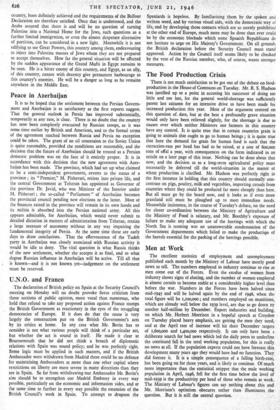Men at Work
The excellent statistics of employment and unemployment published each month by the Ministry of Labour have mostly good news to tell. The numbers employed in industry continue to rise as men come out of the Forces. Even the exodus of women from industry shows signs of abating, and the number of women employed is almost certain to become stable at a considerably higher level than before the war. Numbers in the Forces have .been halved since mid-1945 and will be halved again by the end of 1946, when the total figure will be 1,200,000 ; and numbers employed on munitions, which are already well below the 1939 level, are due to go down by another half-million by December. Export industries and building, on which Mr. Herbert Morrison in a hopeful speech at Croydon on Tuesday placed heavy emphasis, are getting the men they need, and at the April rate of increase will hit their December targets of 1,600,00o and 1,400,000 respectively. It can only have been deliberate search for bad news which led the daily press to underline the continued fall in the total working population, for this is really no news at all. If the population experts could not have forecast this development many years ago they would have had no function. They did foresee it. It is a simple consequence of a falling birth-rate, has been going on for three years, and is likely to continue. Of much more importance than the statistical snippet that the male working population in April, 1946, fell for the first time below the level of mid-1939 is the productivity per head of those who remain at work. The Ministry of Labour's figures can say nothing about this and Mr. Morrison's optimism obscures rather than illuminates the question. But it is still the central question.


























 Previous page
Previous page